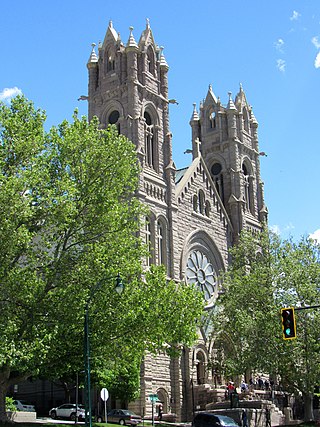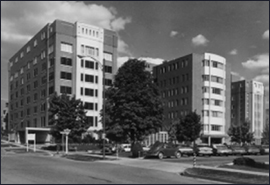
West Jordan is a city in Salt Lake County, Utah, United States. It is a suburb of Salt Lake City. According to the 2020 Census, the city had a population of 116,961, placing it as the third most populous in the state. The city occupies the southwest end of the Salt Lake Valley at an elevation of 4,330 feet (1,320 m). Named after the nearby Jordan River, the limits of the city begin on the river's western bank and end in the eastern foothills of the Oquirrh Mountains, where Kennecott Copper Mine, the world's largest man-made excavation, is located.

Salt Lake City, Utah has many historic and notable sites within its immediate borders. Although the entire Salt Lake City metropolitan area is often referred to as "Salt Lake City", this article is concerned only with the buildings and sites within the official city limits of Salt Lake City.

The Salt Lake Tribune is a newspaper published in the city of Salt Lake City, Utah. The Tribune is owned by The Salt Lake Tribune, Inc., a non-profit corporation. The newspaper's motto is "Utah's Independent Voice Since 1871."

The Cathedral of the Madeleine is a Roman Catholic church in Salt Lake City, Utah, United States. It was completed in 1909 and is the cathedral, or mother church, of the Diocese of Salt Lake City. It is the only cathedral in the U.S. under the patronage of St. Mary Magdalene.

The Diocese of Salt Lake City is a Latin Church diocese of the Catholic Church for the State of Utah in the United States. It is a suffragan diocese, formerly of the metropolitan Archdiocese of San Francisco and, since May 30, 2023, of the Archdiocese of Las Vegas.

Kearns High School is a public high school located at 5525 S. Cougar Lane Kearns, Utah, United States. It was opened in 1966 with its first graduating class graduating in 1967. It serves 9th, 10th, 11th and 12th grade students. The official mascot is a Cougar and the school colors are green and gold. Starting with the 2014–2015 school year, the school now serves 9th grade. At the 2021 graduation ceremony, Kearns High School officials withheld a student's diploma and subsequently charged her $5,000 because a guest popped confetti in celebration when the student's name was called.

The rights of lesbian, gay, bisexual, transgender, and queer (LGBTQ) people in the U.S. state of Utah have significantly evolved in the 21st century. Protective laws have become increasingly enacted since 2014, despite the state's reputation as socially conservative and highly religious. Utah's anti-sodomy law was invalidated in 2003 by Lawrence v. Texas, and fully repealed by the state legislature in 2019. Same-sex marriage has been legal since the state's ban was ruled unconstitutional by federal courts in 2014. In addition, statewide anti-discrimination laws now cover sexual orientation and gender identity in employment and housing, and the use of conversion therapy on minors is prohibited. In spite of this, there are still a few differences between the treatment of LGBTQ people and the rest of the population, and the rights of transgender youth are restricted.

Thomas Kearns was an American mining, banking, railroad, and newspaper magnate. He was a US Senator from Utah from 1901 to 1905. Unlike the predominantly Mormon constituents of his state, Senator Kearns was Catholic.

Judge Memorial Catholic High School is a private Catholic high school located in Salt Lake City, Utah, United States. It is one of three high schools in the Roman Catholic Diocese of Salt Lake City serving students in grades nine through 12. Founded in 1921, the school draws students from across the Salt Lake Valley and beyond. Judge Memorial shares its city location with Our Lady of Lourdes parish and school.
Rowland Hall is an independent private school of roughly 1000 students from preschool to high school on two campuses in Salt Lake City, Utah. Driven by their vision of developing people the world needs, they believe in a transformational education that gives students agency and purpose, connects them to their global community, and empowers them to make the world a better place for all. Founded in 1867, Rowland Hall is the oldest school in Utah.

LDS Hospital is a general urban hospital and surgical center in Salt Lake City, Utah. The hospital was originally owned by the Church of Jesus Christ of Latter-day Saints, but is now owned and operated by Intermountain Healthcare (IHC). LDS Hospital is accredited by the Joint Commission. The hospital has 262 inpatient beds.

Lawrence Scanlan was an Irish-born American prelate of the Catholic Church. A missionary and pioneer bishop, he served as the first Bishop of Salt Lake from 1891 until his death in 1915.

John W. Gallivan was an American newspaper publisher, cable television pioneer, and civic leader. A major figure in the promotion and development of Salt Lake City and Utah's ski industry, he was instrumental in starting the campaign to bring the 2002 Olympic Winter Games to Salt Lake City. Using his position as publisher of the Salt Lake Tribune, "Jack" Gallivan was the driving force behind numerous civic improvement and development projects including the Salt Palace, the Salt Lake Arts Center, Symphony Hall, The Capitol Theatre, and the promotion of light rail. His many contributions to the economic and cultural life of the city were recognized by the community in the naming of the John W. Gallivan Plaza near the center of downtown.
Salt Lake Lutheran High School was a Lutheran school founded in 1984 and located until 2011 in Salt Lake City, Utah, United States. In 2011 the school moved to Riverton, Utah, and took the name Concordia Preparatory School. It closed in 2013.

David Keith Nelson was an American LGBT and gun rights activist. He founded or helped found several LGBT-related nonprofit organizations in Utah and helped direct others. His work with the Democratic Party encouraged many LGBT Utahns to serve as party leaders. His work as a legislative and executive lobbyist accomplished the adoption of several LGBT- and weapon-friendly state and local laws, rules, ordinances and policies, and the rejection of other legislation.
Carl Martel Neuhausen was an American architect based in Salt Lake City, Utah. He designed a number of buildings that survive and are listed on the U.S. National Register of Historic Places.

The Mormon Pioneer Memorial Monument is a private cemetery and memorial. It is the burial site of Brigham Young and several of his wives and children. Part of the property was dedicated to the Mormon pioneers who died making the journey to Utah from Illinois and other parts of the world between 1847 and 1869.

On Thursday, January 15, 1987, SkyWest Airlines Flight 1834, a Swearingen SA-226TC, and a Mooney M20 were involved in a midair collision at 12:52 MST (UTC−7) near Kearns, Utah, a suburb southwest of Salt Lake City. All ten aboard the two aircraft were killed: two pilots and six passengers aboard the METRO II and two aboard the Mooney.

Amanda Inez Knight Allen was a Mormon missionary and a Utah politician. In 1898, she became one of the first two single women to be missionaries for the Church of Jesus Christ of Latter-day Saints.

The Kearns-St. Ann's Orphanage, at 430 East 2100 South in South Salt Lake, Utah, was built in 1890. It was designed by architect Carl M. Neuhausen. Later serving as Kearns-Saint Ann Catholic School, it was listed on the National Register of Historic Places in 1980. According to its NRHP nomination, the orphanage is significant partly for its architecture, with "modest decorative elements allud[ing] to Renaissance and Mannerist" styles, representing "the important educational and religious contributions to Utah society of Bishop Lawrence Scanlan and Thomas and Jennie Kearns".




















